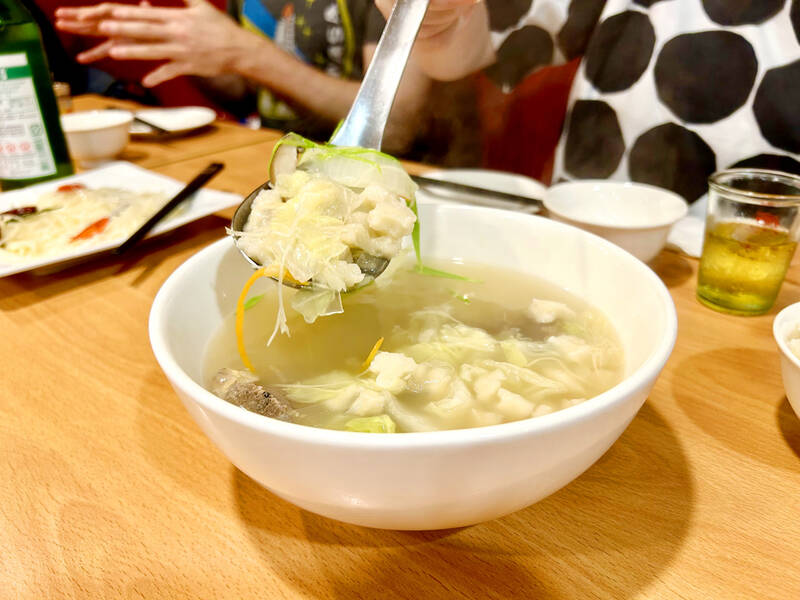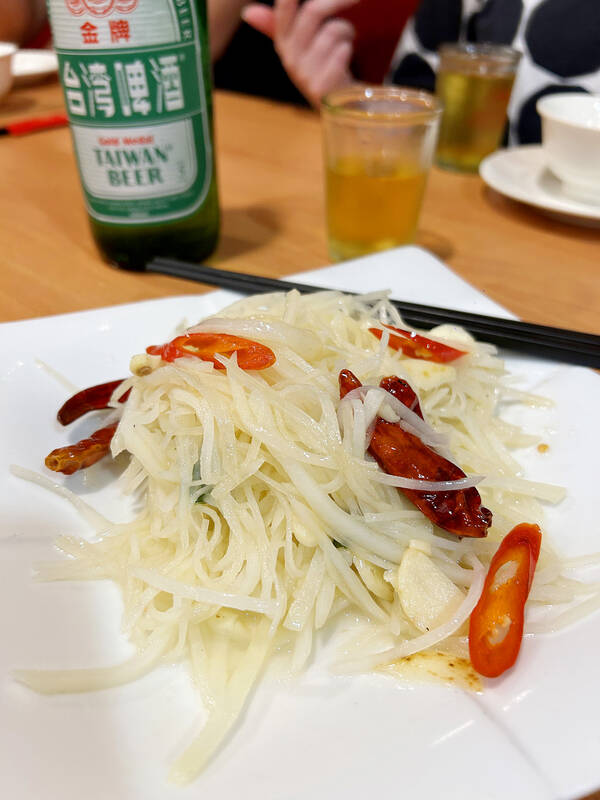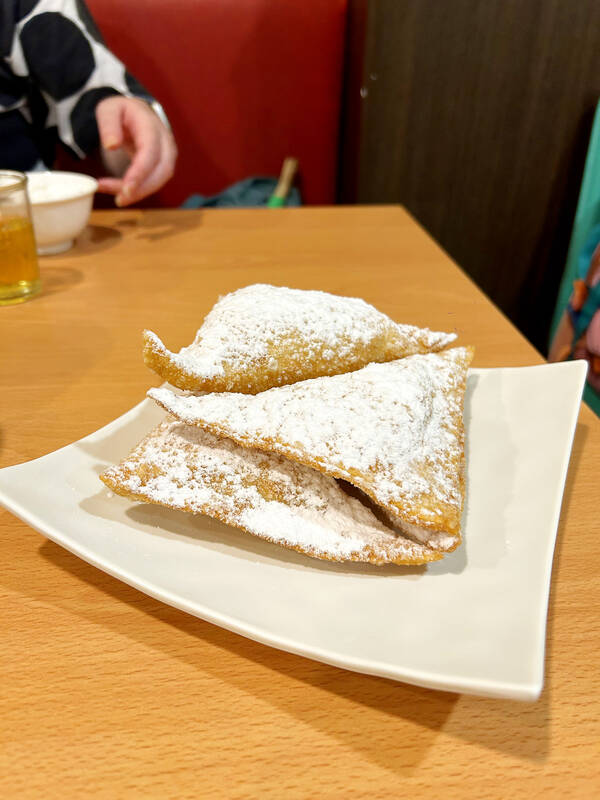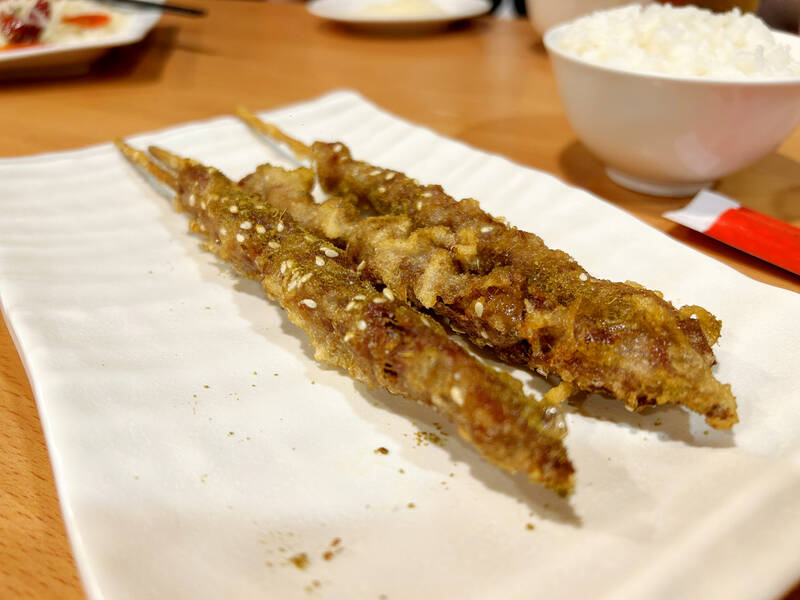Shao Shao Ke (勺勺客) specializes in Shaanxi cuisine, China’s arid, north-western province home to Xian and the Terracotta Warriors. As the starting point of the ancient Silk Road, it straddles the border between eastern China’s shiny metropolises and western China’s nomadic living and Uighur culture.
It’s where tangy vinegar and familiar Chinese flavors meet the spice and warmth of Muslim-minority cooking, adding rich cumin, juicy lamb and Central Asian spices to a melting pot of a cuisine.
Admittedly, I’d never heard of Shao Shao Ke, having rarely encountered Shaanxi cuisine in Taipei — bar a night market Rou Jia Mo (肉夾饃) — but I’m led here by a friend visiting from Ho Chi Minh City. On her second trip to Taipei, this is a restaurant she “had to come back to.”

Photo: Hollie Younger
I call to make a reservation and receive an audible sigh on the other end of the phone. I apologize to the weathered old boss for the imposition.
But, I’ve heard if you don’t make a reservation, you will encounter the same disgruntled huffing and puffing at the door. It’s all part of the charm. And this place does fill up, remarkably busy for a Wednesday evening in torrential rain.
I arrive at the restaurant and it’s like a time vortex to the 1990s. It reminds me of a Taiwanese Grandma’s house with kitsch Lunar New Year decorations, mismatched old chairs in faded primary colors and a dog-eared, laminated book of a menu that looks like it’s seen every service of the past two decades. Don’t even dare to dream of ambient lighting or background music.

Photo: Hollie Younger
But the patrons keep coming back. The food speaks for itself. Service can be a little slow and dessert must be ordered with the mains to give them time to prepare — but it’s worth it.
The bestseller here is paomo (泡饃), a Shaanxi specialty where unleavened bread is crumbled into a light broth, sort of like a noodle soup but replace the noodles with stodgy little pillows of dough that soak up all that brothy goodness.
We’re handed a small bowl with a pita bread-sized piece of dense white bread, which we crumble ourselves into bite-sized pieces and hand back to the boss. It’s a fun little DIY ritual we see occurring at every table in the restaurant.

Photo: Hollie Younger
We’ve gone for the lamb soup paomo (NT$200), a very light, clear broth with onions, veggies and large hunks of stewed lamb on the bone, enough to share between four. More than anything, it’s a fun new experience.
Cumin and lamb are staples of the Shaanxi cuisine and its Silk Road legacy. We opt for a plate of their deep-fried lamb skewers (NT$45 each) and they’re crispy on the outside but oh-so juicy on the inside, not fatty or gamey just luscious chunks of melt-in-the-mouth lamb with a strong hit of cumin.
Next up are the roasted pork ribs (NT$380) — a full crown with skin roasted until there’s an audible crunch around the table. The inside stays glossy and silky as it hugs the bone, white fat oozing from between the ribs. This isn’t overly spiced or dressed up, just dipped in a small ramekin of Chinese five spice. But the meat itself is the star, unctuous and crispy in equal parts.

Photo: Hollie Younger
Before we succumb to the meat sweats, we grab a tudousi (土豆絲, NT$150), something more familiar from my time in Beijing. Stir-fried shredded potatoes, more akin to radish in look and mouthfeel, are mixed with chilies and spices. As the Shaanxi palate leans much more sour, Shao Shao Ke’s rendition features a healthy dose of vinegar, which helps cut through the meaty feast.
Lastly, we order their famous dessert, seen at every table across the room and taking half an hour to prepare, the “deep fried mozzarella cheese with sugar ground” (NT$40 each).
Now, you’d be forgiven for thinking this was a giant mozzarella stick fashioned into an empanada and covered in powdered sugar. It gives a long, stringy, satisfying cheese pull, though it’s not actually mozzarella, but somehow a form of tofu.
We try to order one between two to share and our request is denied. They really want everyone to try this. Make sure to save room, it’s cheesy, not-too-sweet and a great way to end the meal.
We wash our feast down with several bottles of Taiwan beer (NT$70) and when the bill comes, the prices also seem to be stuck in the 90s.
Shao Shao Ke isn’t trying to impress anyone. It’s nostalgic, slightly chaotic and deeply comforting — a place where the boss grumbles, the tables wobble and the food does all the talking.
Overall, it’s affordable, authentic and an all-round good feed, great for those looking to try something a little different.

Oct. 27 to Nov. 2 Over a breakfast of soymilk and fried dough costing less than NT$400, seven officials and engineers agreed on a NT$400 million plan — unaware that it would mark the beginning of Taiwan’s semiconductor empire. It was a cold February morning in 1974. Gathered at the unassuming shop were Economics minister Sun Yun-hsuan (孫運璿), director-general of Transportation and Communications Kao Yu-shu (高玉樹), Industrial Technology Research Institute (ITRI) president Wang Chao-chen (王兆振), Telecommunications Laboratories director Kang Pao-huang (康寶煌), Executive Yuan secretary-general Fei Hua (費驊), director-general of Telecommunications Fang Hsien-chi (方賢齊) and Radio Corporation of America (RCA) Laboratories director Pan

President William Lai (賴清德) has championed Taiwan as an “AI Island” — an artificial intelligence (AI) hub powering the global tech economy. But without major shifts in talent, funding and strategic direction, this vision risks becoming a static fortress: indispensable, yet immobile and vulnerable. It’s time to reframe Taiwan’s ambition. Time to move from a resource-rich AI island to an AI Armada. Why change metaphors? Because choosing the right metaphor shapes both understanding and strategy. The “AI Island” frames our national ambition as a static fortress that, while valuable, is still vulnerable and reactive. Shifting our metaphor to an “AI Armada”
The consensus on the Chinese Nationalist Party (KMT) chair race is that Cheng Li-wun (鄭麗文) ran a populist, ideological back-to-basics campaign and soundly defeated former Taipei mayor Hau Lung-bin (郝龍斌), the candidate backed by the big institutional players. Cheng tapped into a wave of popular enthusiasm within the KMT, while the institutional players’ get-out-the-vote abilities fell flat, suggesting their power has weakened significantly. Yet, a closer look at the race paints a more complicated picture, raising questions about some analysts’ conclusions, including my own. TURNOUT Here is a surprising statistic: Turnout was 130,678, or 39.46 percent of the 331,145 eligible party

The older you get, and the more obsessed with your health, the more it feels as if life comes down to numbers: how many more years you can expect; your lean body mass; your percentage of visceral fat; how dense your bones are; how many kilos you can squat; how long you can deadhang; how often you still do it; your levels of LDL and HDL cholesterol; your resting heart rate; your overnight blood oxygen level; how quickly you can run; how many steps you do in a day; how many hours you sleep; how fast you are shrinking; how